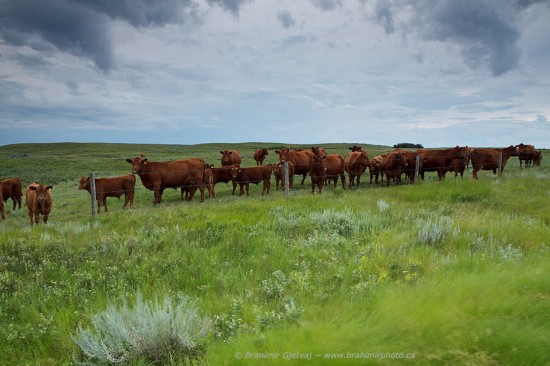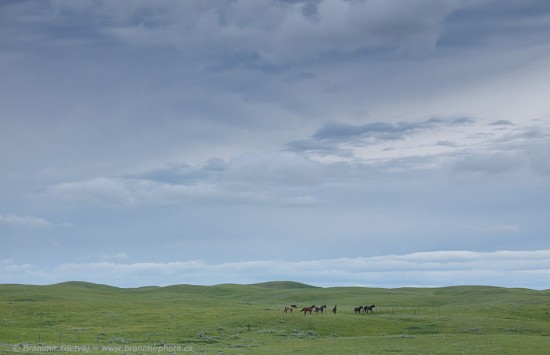Earlier this year I wrote a post about the largest land transfer in to occur in the recent Canadian history, affecting management of 9,290 square kilometres of native prairie (see the article titled “What is the future for PFRA community pastures?“). In a nutshell, the Canadian government decided that it does not want to look after some of the largest un-fragmented tracts of grasslands found anywhere in the world, and told the three prairie provinces that they can do whatever they want with the land that used to be under the Prairie Farm Rehabilitation Administration (rather successful) supervision for over 75 years.
There are 62 federal community pastures in Saskatchewan, totaling 7,160 square kilometres (1,77 million acres). The land for the community pastures is almost all provincially owned. The province has said that it does not want to manage the former federal pastures, and plans to sell or lease the land to current pasture patrons (farmers and ranchers who have been grazing livestock on the pastures). In contrast, the government of Manitoba plans to keep the land under public ownership and lease it to the former patrons.
In the meantime, two excellent articles about this pivotal moment in the Canadian history have been published in influential public media: one in this weekend edition of The Globe and Mail “Why is Ottawa abandoning swaths of prairie grassland?” by Trevor Herriot (accompanied by an article “Range rider is a cowboy conservationist” presenting the views of one of the PFRA pasture managers who will be directly impacted by the changes).
The second article is by a writer Candace Savage in the April edition of Canadian Geographic, “The future of natural prairie pastures“. I am quite proud that editors of the magazine picked one of my images to illustrate the story.
A non-profit citizens group Public Pastures – Public Interest (PPPI) released a set of principles to protect the wider public interest during the transition of PFRA community pastures. PPPI is a group of Saskatchewan residents who believe that the benefits from public pastures to livestock producers and the people of Saskatchewan can best be served by continuing public ownership of these last vestiges of native grasslands.
This set of principles has been endorsed by over 30 45 Canadian and international groups and organizations, including the Alberta Wilderness Association, Bird Studies Canada, Canadian Parks and Wilderness Society, International Union for the Conservation of Nature (Switzerland), National Farmers Union, Nature Canada, Nature Saskatchewan, National Audubon Society (USA), Saskatchewan Environmental Society and Temperate Grasslands Conservation Initiative.
Here are the six principles developed by the Public Pastures – Public Interest, and suggestions for the strategy to move forward.
A Vision for the Future of Saskatchewan Heritage Rangelands
The Principles
1. Keep ownership of the PFRA pastures in the public domain.
This is the best way to balance diverse interests, to preserve the integrity of the pastures, and to ensure that the legacy of the pastures is secured for future generations.
2. Maintain livestock grazing as a priority.
Livestock grazing is essential to the management of healthy prairie grasslands and to maintaining cattle and other livestock production now and in the future. This is a win-win arrangement that benefits producers and preserves the natural ecosystems in the pastures.
3. Utilize professional pasture managers.
It has taken decades to build up the expertise needed to manage the livestock and grazing, the ecosystems, and the habitats for indigenous species and species at risk. Pasture managers are part of a system-wide team that helps them to improve their individual practices and provides coordinated support. Pasture patrons have dubbed their PFRA pasture manager as ‘their best asset.’
4. Preserve the natural landscapes and ecological integrity of the pastures.
Preservation of the natural landscapes and ecology of the pastures is important at a World level. They contain the largest contiguous blocks of original prairie grasslands in the Northern Great Plains. They are home to many indigenous species, including 32 species at risk found in 55 of the pastures.
5. Protect the cultural and historic significance of these heritage rangelands.
The pastures contain significant heritage and archaeological sites, and sacred and ceremonial sites that are still significant in contemporary First Nation and Métis cultures. They have played a key role in Canada’s agricultural development and preserve the tradition of working cowboys. The pastures are part of the history, culture, and vitality of rural Saskatchewan.
6. Recognize and sustain the investment in the public benefits provided by publicly-owned community pastures.
Through the visionary action taken by key agricultural leaders more than 75 years ago, public resources were applied to restore degraded land to a state that yielded economic production and environmental benefits year after year. The PFRA community pastures provide one of the best examples of a “‘triple-bottom-line” enterprise: they provide an environmental, social and economic dividend to all Canadians. This investment needs to be continued now and in the future.
A Strategy Forward
A. Work with stakeholders to establish an inclusive Transition Plan.
We need a clear and transparent transition plan to manage the changes to the PFRA community pastures. Participants in the planning should include: governments, pasture patrons, municipalities, First Nations, industries, conservation organizations, range managers and others. The goal should be to ensure that the best-management practices developed through the PFRA continue to serve pasture patrons, protect our natural and cultural heritage, and provide benefits for the people of Saskatchewan.
B. Take the time to get it right.
The decisions from the federal government were made without consultation. The Saskatchewan government has bought a little time from the federal government to do some review of the situation, but forcing a decision to dispose of the first ten pastures by the Fall of 2013, as currently planned, is too rushed. Time is needed for the general public, who are the owners of the land, and the various stakeholders, to determine what the future of the community pastures will be and how they can be preserved for future generations.
You can download the Saskatchewan Heritage Rangelands Backgrounder (pdf document, 622 kB) which provides more information about the PPPI vision principles.


